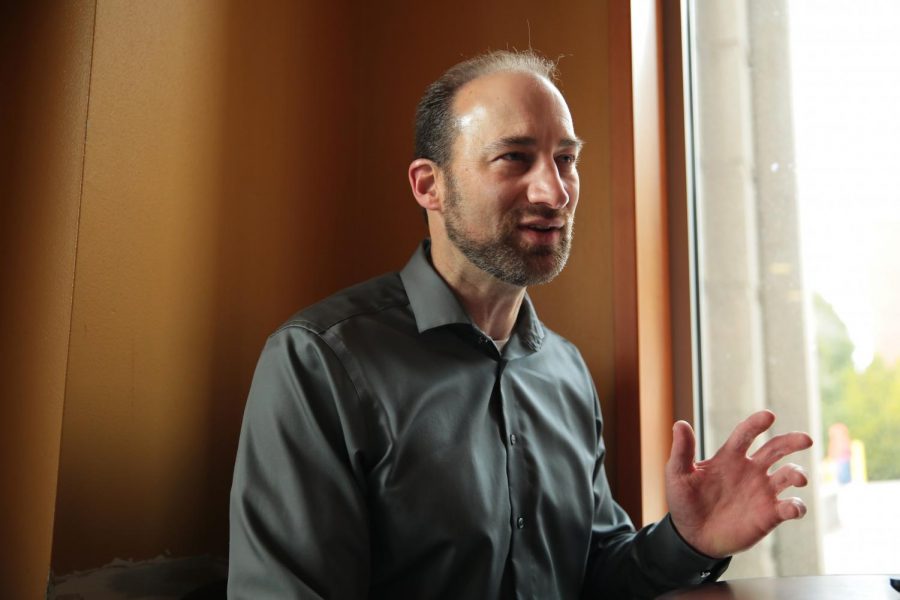Quirks, rumors about buildings on campus
WSU’s architecture more than just concrete slabs; structures give insight on university’s values, prestige
BENJAMIN MICHAELIS | THE DAILY EVERGREEN
Phil Gruen, WSU associate architecture professor, talks about the designs of buildings around campus and how they came to be.
November 15, 2018
Some of WSU’s most interesting hidden history lies in the architecture on campus.
If you toured WSU as a prospective student or during Alive! Orientation, you probably heard some strange stories about the buildings around campus.
Every building was designed with a practical use in mind, but the stories passed along by fellow Cougs rarely teach the true purpose and instead create a living history of the WSU architecture.
“There are the facts about these buildings, and then there are the stories … I’m more interested in the stories,” said Phil Gruen, an associate professor of architecture in the School of Design and Construction.
Thompson Hall
Thompson Hall is situated near the residence halls on Hillside and is across the street from the Murrow building. The old administration building, now home to the School of Languages, Cultures and Race, is one of the most notable on campus.
With its gray stone base and red brick facade, Thompson Hall is a beautifully constructed building. However, the thing that stands out about Thompson is not its Romanesque architecture, but the two towers, one of which is missing a cone.
A popular rumor about the missing cone states that leaving the building unfinished allowed the university to avoid paying state taxes on it. While this seems interesting, this isn’t the case.
An article from 1893 in the Pullman Tribune reveals the second tower was intentionally made flat to hold “meteorological instruments.”
Though this might address why one of the cones is missing, it doesn’t provide any closure about the asymmetry of Thompson. Why would the architects design two towers if one was meant to be conical and the other was to be left flat at the top?
Cougs have many theories about the answer to this question, but no one knows for sure why Thompson is so unusual in its design.
“President [Enoch] Bryan and other administrators at the time were very interested in having the ability and mandate to create … a dignified environment for students and faculty,” Gruen said.
While the flat tower may serve the functional purpose of holding instruments to observe weather, WSU’s early administrators may have intended for it to serve as a mark of sophistication and prestige for the university. Given that it is still a talking point for many around campus today, it seems they accomplished their goal.
Webster Physical Sciences Building
The Kate B. Webster Physical Sciences Building has 14 stories and is the tallest building in Pullman. It was built in the 1970s to house the science departments in one location.
The tower stands apart on campus and not just because of its height. While many of the halls around WSU are built with red brick, Webster is almost entirely made of concrete except for some brick detailing on the front.
“The idea of a science tower was quite prevalent,” Gruen said. “There was a lot of federal funding at that point coming into universities to fund research.”
Like Thompson, Webster may have been a symbol of prestige for WSU. At the time of its construction, society valued technological advancements, efficiency and rational thinking, and having an impressively large science building would signal that WSU also valued these things.
Even though Webster is meant to stand for rationality, there are some rumors going around about it that aren’t completely true.
You may have been told that Webster is the tallest building in the state of Washington because of Pullman’s elevation. While this is a nice story for Cougs to share with others, it isn’t factual.
The elevation of Pullman is about 2,300 feet. The elevation of Mount Rainier is much higher, so any building built on Mount Rainier, even a one-story visitor center, would beat out Webster as the tallest building by elevation, Gruen said.
“Webster is, as far as I know, the tallest human-made object in an [80-mile radius] until you get to Spokane,” Gruen said.
Other tales
Cougars have an incredibly strong attachment to WSU, part of which stems from the time we spend in buildings around campus. The longer we spend here, the more we discover about the buildings we have been passing by for so long.
One examples is the fact that Heald and Eastlick halls are connected but the floors are offset by several feet, possibly because of changing building codes, Gruen said.
Whether or not we know the truth about the buildings on campus, we will continue to share the things we have heard and continue to spread the culture that connects us to these physical spaces.
“Stories resonate longer and can begin to become the belief system around which people attach meaning to a place,” Gruen said.
If you hear a story about a place on campus, know that you are taking part in a longtime Cougar tradition and feel free to pass it along.






















